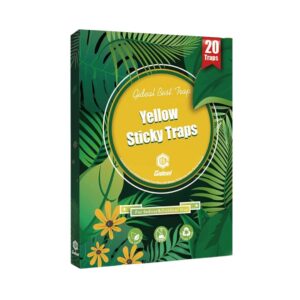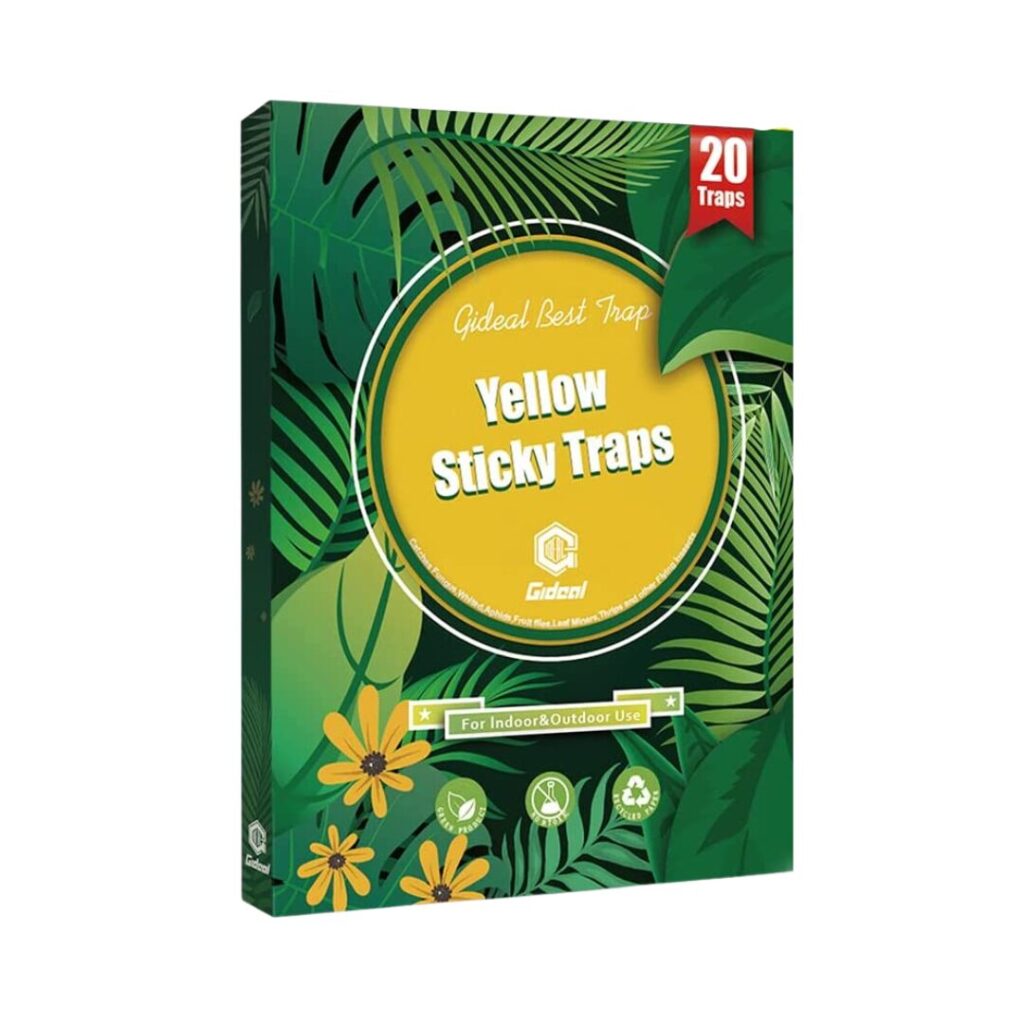No matter if the flies are in your kitchen, basement, or screened-in porch, it can be a nuisance to get rid of flies. As opposed to a swatter that requires you to chase them around your home, a trap does the work for you after being set, helping you fix your fly problem.
To help you select the right trap for your home, we at the This Old House Team researched the best fly traps on the market today.
Here are our top recommendations.



Top 5 Fly Traps
- Best For Windows: Catchmaster Clear Window Fly Traps
- Best For Plants: Gideal Dual-Sided Yellow Sticky Traps
- Best For Outdoor Use: Flies Be Gone Fly Traps
- Best For Indoor Use: Katchy Indoor Insect Trap
- Best Plug-In Trap: Safer Indoor Plug-In Fly Trap
Compare Top Fly Traps
| Product | Type | Number of Traps | Bait | Indoor/Outdoor |
|---|---|---|---|---|
Catchmaster Clear Window Fly TrapsCheck Price | Adhesive surface | 12 | None | Indoor |
Gideal Dual-Sided Yellow Sticky TrapsCheck Price | Adhesive surface | 20 | None | Both |
Flies Be Gone Fly TrapCheck Price | Covered chamber filled with water and bait | 2 | Non-toxic | Outdoor |
Katchy Indoor Insect TrapCheck Price | UV light attracent with adhesive board | 1 reusable | None | Indoor |
Best For Windows
Catchmaster Clear Window Fly Traps
These clear, disposable fly traps stick to your windows to capture insects as they fly by, attracting them with the warmth and light of the sun through the window. Because they come in a 12-pack, our team found that they they can collect dozens of flies before needing to be replaced.
Pros and Cons of Catchmaster Clear Window Fly Traps
- Nontoxic formula free from harsh chemicals
- Small, transparent design makes it barely visible
- Comes in a pack of 12
- Can be difficult to remove from surfaces
- Accumulation of flies over time can be unappealing
Key Features
What People Are Saying About The Catchmaster Clear Window Fly Traps
We noted that those who liked these traps said that they stuck well to windows and caught a large number of flies. However, those who were unhappy claimed that it was tough to remove the traps from windows once they were full. Others wished that the traps had bait to more effectively lure insects.
Best For Plants
Gideal Dual-Sided Yellow Sticky Traps
We like that these sticky traps come with stakes and twist ties to attach to your plants or stand in the soil. These fly killers eliminate a wide variety of flies from your garden, including whiteflies, and fruit flies, and are made from non-toxic materials with a UV-resistant adhesive.
Pros and Cons of Gideal Dual-Sided Yellow Sticky Traps
- Waterproof and heat-resistant
- Safe for both indoor and outdoor use
- Includes 20 twist ties and two stands
- Bright color makes it difficult to hide
- Not reusable
Key Features
What People Are Saying About The Gideal Dual-Sided Yellow Sticky Traps
Many customers said that these traps were easy to use, worked quickly, and didn’t have an overpowering scent. However, we found that those who left negative reviews pointed out that they sometimes caught bees, wasps, or birds. Others claimed that they didn’t work effectively without adding apple cider vinegar or another attractant.
Best For Outdoor Use
Flies Be Gone Fly Trap
Outdoor fly traps are an effective way to eliminate flies before they can get inside, making them useful if you have outdoor animals or edible plants that bring flies to your property. We were impressed with the designed lid of these traps that attached to their bait- and water-filled bag.
Pros and Cons of Flies Be Gone Fly Trap
- Features a unique, beehive design
- Includes a hanging strap
- Snapping lid makes filling process convenient
- May give off and unpleasant odor
- Not designed for indoor use
Key Features
What People Are Saying About The Flies Be Gone Fly Trap
Our research indicated that satisfied customers liked that these bags were easy to set up and caught a large amount of flies in little time. However, those who were unsatisfied claimed that they sometimes spilled or leaked. Others said that the traps were unusable after a rainstorm because they filled with water.
Best For Indoor Use
Katchy Indoor Insect Trap
Once flies enter your home, it can be tough to get rid of them. Our team liked that this indoor fly trap is designed to lure them with a UV light, suck them in with a fan, and trap them with a sticky board. Additionally, this trap has a sleek design that won’t look out of place in your home.
Pros and Cons of Katchy Indoor Insect Trap
- Also kills gnats, mosquitoes, moths, and other small flying insects
- Uses easy-to-remove, replaceable glue boards
- Features multiple fan-speed settings
- Is more expensive than other trap types
- Not effective for large bugs
Key Features
What People Are Saying About The Katchy Indoor Insect Trap
Most customers we found felt that this trap was easy to use, quiet, and also effective at eliminating mosquitoes. However, those who weren’t happy said that some flies were able to fly away instead of being sucked in because the fan wasn’t powerful enough.
Best Plug-In Trap
Safer Indoor Plug-In Fly Trap
We found that this indoor fly trap works as a multi-insect killer that is designed to plug directly into any standard household outlet. It contains no chemical pesticides and traps flies, fruit flies, moths, gnats, and other flying insects. Two StickyTech glue cards are included with your purchase.
Pros and Cons of Safer Indoor Plug-In Fly Trap
- Easy to use and refillable
- Naturally attracts insects with a UV LED light
- Rotates to fit any indoor outlet
- Capacity limited compared to other fly traps
- Not highly effective against larger, heavier flie
Key Features
What People Are Saying About The Safer Indoor Plug-In Fly Trap
The majority of customers who revived this two-in-one indoor fly trap reported that it was easy to use and effective. Happy customers also liked that the fly trap gave off a subtle but pleasant glow, functioning as a night light. On the other hand, we found that critical feedback included a lack of effectiveness against particularly large insect infestations, and that the trap worked better at night rather than in the daytime.
Buying Guide for Fly Traps
Whether you have one stray housefly or you need to get rid of a fruit fly infestation, you could benefit from a fly trap. To decide which fly trap is best for your needs, we recommend considering the following factors.
Type
There are several types of fly traps, with some of the most popular being:
Adhesive
These traps have a sticky surface. Once flies come into contact with the adhesive, they can’t escape. Eventually, they die from starvation.
Container
Container traps lure flies in with bait and kill them with either poisoning, drowning, or dehydration.
Zap
Bug zappers electrocute the fly once it makes contact with the electric grid. This kills the bug instantly.
Location
Traps are designed for inside, outside, or both. For example, zap traps should only be used on dry days outdoors because precipitation and electricity don’t mix. On the other hand, container traps typically have a hook to hang on a post. Choose a trap that works wherever you’re seeing a large number of flies.
Safety
Most fly traps use either bait or UV light to attract flies. UV light is considered less dangerous, but it can damage your eyes if you stare at it directly. Bait may be made from chemicals, so if you have pets or children, keep these traps out of reach, or opt for a pesticide-free bait. Zap traps also pose a safety risk if kids or pets touch them.
Price
Most fly traps are inexpensive and will catch a large number of flies before they need to be replaced. Reusable traps may be more expensive but will provide good value since you don’t need to be constantly shopping for a replacement. Electric traps will be the most expensive type of trap but are effective at killing a high number of flies and can last for months or even years if well-maintained.
Capacity
Consider the capacity of the fly trap, especially if you’re using it in a commercial or high-traffic area. A larger trap will be able to hold more flies and require less frequent emptying.
Durability
Look for a fly trap that is durable and made from high-quality materials. A well-made trap will last longer and be more effective at catching flies.
Care
Another factor to consider is how easy the traps will be to care for and maintain. Most traps require some form of disposal, which may not be ideal if you don’t like being near dead flies. Adhesive-type traps typically need to be unpeeled and thrown away, while water traps should be cleaned after being dumped out.
Tips and Tricks for Using a Fly Trap
Most fly traps should automatically attract and trap flies when they venture too close. However, knowing exactly where to place the trap helps yield the best possible results. Here are a few tips we think will help maximize the effectiveness of your new fly trap.
- Place your fly trap in an area where flies are most likely to be found, such as near doors or windows. Keep the trap away from your kitchen or other food preparation areas.
- Flies are attracted to sweet or decaying odors, so use bait that mimics those smells. This may include sugar water, apple cider vinegar, rotting fruit, or fruit juice.
- Change the bait regularly, ideally every few days. As the bait in the trap starts to decompose, it will become less effective over time.
- Use multiple fly traps for the best results. Place them strategically to cover the entire area and maximize their effectiveness.
- Be patient. It may take some time for the trap to start working, so give it a few days to start attracting and collecting flies.
Frequently Asked Questions About Fly Traps
How long do fly traps take to work?
If your trap has light or fly bait, flies should come buzzing over within minutes. However, if you have a sticky glue trap, it may take a little longer for flies to find their way over.
Where should I put a fly trap?
It depends largely on where you’re having the biggest issue. If you have flies inside your home, set up traps where they’re most likely to congregate, such as near windows and in the kitchen. If you want to prevent flies from getting inside, consider on the porch or deck, in the garden, or on a tree.
Are there home remedies that kill flies?
Yes. There are alternative ways to get rid of flies if you want a natural remedy or traps aren’t doing the trick. A mixture of vinegar and dish soap is a popular way to attract flies and poison or drown them. Having basil plants around your home or yard is another way to repel flies, as they don’t like the scent.
Why Trust The This Old House Team
This Old House has empowered homeowners and DIY-ers for more than four decades with top-notch home improvement advice in the form of television programs, print media, and digital content.
The This Old House Team focuses on creating in-depth product and service review content. To date, we’ve published over 1,600 reviews on products in the home space, from fertilizer and pruning shears to patio furniture and snow blowers.
Once we conclude our research [and testing phases], we craft a comprehensive, user-friendly article of recommended products and additional information to help our readers make the right purchase.




